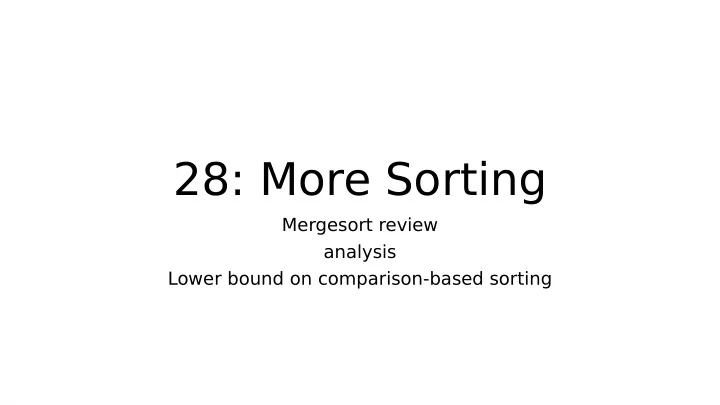

28: More Sorting Mergesort review analysis Lower bound on comparison-based sorting
Mergesort: A difgerent approach to sorting • Divide and conquer • So far we’ve divided into an item and a shorter list • Alternative: divide into two equal-sized lists • Huge performance improvement • Used across computer science!
Merge sort idea • Divide input into two lists somehow • Sort each one • “merge” together the results • Can be made "stable" so that sorting (1,A) (2, Q) (1, C), based on the "int" part, gives (1,A) (1, C) (2, Q) instead of (1, C) (1, A) (2, Q).
Revised recursive diagram • Input: two sorted lists • Output: sorted list containing all items of both lists • Original input: [1; 3; 6] [2; 7; 8] • Recursive input: [3; 6] [2; 7; 8] • Recursive output: [2; 3; 6; 7; 8] Cons smaller of two heads onto result of merging everything else • Overall output: [1; 2; 6;7; 8]
•
•
Analysis •
•
T otal work diagrams for analysis [2; 8;3;1;4;6;2;5 4+4=8 4+4 = ] [2; 8;3;1] [4; 6; 2; 8 2+2+2+ 5] 2+2+2+ 2 =8 2= 8 [2; 8] [3;1] [4; 6] [2; 5] 1*8 = 1* 8 = 8 8 [2] [3] [6] [1] [4] [5] [8] [2] Green: Work at each level to do split. Red: work at each level to do merge. T o split a list, it takes n time, where n is the length of the list. So at each level, it takes 8 amount of work to do split. Additionally, in order to merge a list, it takes n time, where n is the length of the list. So at each level, it takes 8 amount of work to do merge. There are log n levels, because the starting list is length 8, and log 8 = 3. So, it takes 16 log 8 amount of work for mergesort, or 2n log n. So merge sort is in O(n -> n log n).
"Paths through the mergesort code" • Think back to the "length" procedure. • In each recursive call there was a "cond" that made one of two choices. • We could draw a picture to indicate possible ways that "length" might work
Paths through length cons empty cons empty cons empty
Same deal for sorting using < • Every possible input consisiting of the numbers 1…n in some order corresponds to a path through a tree of choices • One "choice" for each comparison (e.g., if hd1 < hd2) • If we imagine taking that same "path" through the code, ignoring the actual data, the input data ends up shuffmed by the time we get to the output • For every possible shuffming of the input data, there must be a difgerent path! • If there are k possible shuffmes, the tree must have at least k leaves.
Paths through sorting algorithm [1; 2; 3]
How many ways to shuffme n items? • Let S(n) denote the number of ways to shuffme n items • Shuffme n-1 of them; then place the nth one in one of n positions. S(1) = 1 S(n) = n S(n-1) for n > 1 Conclusion: S(n) = n!
Recall earlier result about trees •
Facts • Our "execution tree" for sorting a shuffming of 1…n has leaves • A tree with leaves has depth at least log • Our execution tree has depth at least • How big is that?
•
•
Recommend
More recommend